First Lady Of Las Vegas – Legends of America (original) (raw)
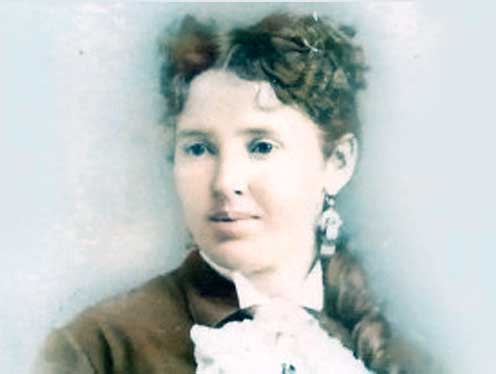
Helen Stewart, First Lady of Las Vegas
by Anthony Dee Varrone
Her wagon groaned through caliche dust as it eased down the mile and a half trail back to the Las Vegas Ranch. Helen Stewart was returning home with the body of her husband, Archibald. Late in the day on July 13th, 1884, she received a terse note from Conrad Kiel who owned the neighboring ranch to the North of the Stewart’s.
“Mrs. Sturd Send a Team and take Mr. Sturd away
he is dead. – C. Kiel”
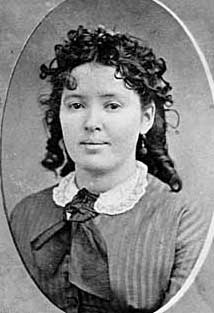
Helen Stewart as a young bride.
The suddenly widowed young woman unhitched the wagon and saw to the horses. Archie would need a coffin, but planed lumber was scarce around here. So the outside doors of the ranch house were removed from their hinges and the wood, after careful disassembly was fashioned to house his remains. With her own hands, she prepared his body for burial as best she could. She read the service over him from the Episcopal Book Of Common Prayer, ending with the Twenty-Third Psalm, their favorite scripture. Only after the last shovel of earth was replaced over him did she give up her grief to tears.
Helen J. Stewart was born Helen Jane Wiser on April 16, 1854, in Springfield, Illinois. When she was nine years old her family made the long trip across the plains and, after a brief stay in Carson Valley, Nevada, moved on to Sacramento, California.
Soon after her marriage to Archibald Stewart, shortly before her nineteenth birthday, they came to live at the Knapper ranch, near Pioche. There, Archie continued to build his business as a freighter and cattle dealer. Soon Stewart acquired an isolated ranch at Pony Springs and it was there that their eldest son, William James, called Will, was born. The Stewarts then moved into Pioche which was enjoying its heyday as a silver-mining town, large and prosperous. There followed two more children: Hiram Richard and Flora Eliza Jane, who was called Tiza by the family.
In 1882 they settled at what became the Las Vegas Ranch, after O. D. Gass defaulted on a loan from Stewart of $5000 in gold at 2.5% interest per month for which Gass eventually mortgaged 640 acres known as the Las Vegas Ranch, and 320 acres of the adjacent Spring Ranch, as collateral. Helen dreaded the idea of the isolation she was moving back to after the bustle of Pioche, but in April 1882, they began the long trip to the Las Vegas valley. The Stewart’s brought horses, cattle, assorted livestock, and farming implements and began to systematically cultivate the land. The ranch became a major supplier of alfalfa, grain, vegetables, fruit, cured beef, and wine.
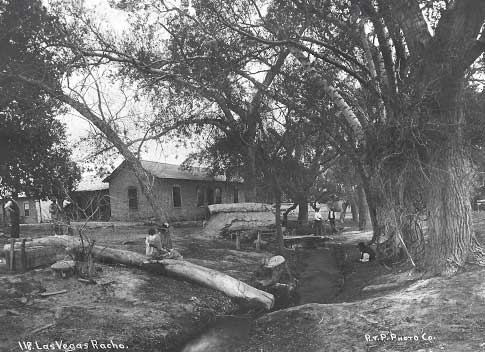
Las Vegas Ranch
As their crops came in, the harvest was hauled around to local mining camps or to the nearest market at Eldorado Canyon, sixty miles away. There the settlers could also buy the necessities and luxuries that were brought up the Colorado River by steamboat.
The family thrived and five months after settling in, they had another daughter, Evaline La Vega, known as Eva.
The Lord had blessed them with such great bounty in two short years, surely He would not abandon them now. Helen always held fast to her strong faith, especially now as she smoothed the soil over her husband’s grave. This would be the first of seven graves that would be dug out of the area of the ranch known as “Four Acres.” As she trailed the few mourners, most from the local Paiute tribe who Archie hired as ranch-hands, she thought about another child, as yet unborn. For the young widow was in the third month of pregnancy and on January 25, 1885, gave birth to Archibald Junior, her Archie. He would be her fifth, last and favorite child.
If Helen had packed it in and moved her brood to more civilized climes, no one would have blamed her. The Las Vegas Valley and circumstance had conquered bigger and stronger than she. There would be several offers she entertained over the next years to sell out, but here she was destined to stay. The loneliness of the isolated ranch was occasionally relieved by travelers on a lone stagecoach, or settlers in small wagon trains who stopped by to refresh themselves and their tired teams at the Las Vegas Spring on the ranch property. There were few women among her guests, so those that came were made particularly welcome. Helen was known, even then, as a gracious hostess and her ranch house became the social center for this sparsely populated region. As the Los Angeles-Salt Lake City route became more established, the Las Vegas Ranch was soon a routine stopover for the teamsters and wagon masters that brought first the few – then the thousands – following the rumors of wealth and open land in the last western frontier.
Naturally, she was concerned that she and her family were unprotected from renegade Indians and assorted desperate characters seeking anonymity in the wilderness. But any rowdy or troublesome visitor would be kindly invited to join in the duck hunting along the Las Vegas creek, a favorite form of recreation for the women of the ranch. Helen would then display such quick and deadly marksmanship that those men would take the choice to mind their manners and be respectful of the quietly formidable little woman, her family, and her property. The local Paiute tribe, after a somewhat rocky start, came to love and honor Helen for the concern and effort she gave to their well-being. From them, she would develop a life-long interest in the native art of basket weaving, eventually owning the finest collection in the West.
The children were growing now and becoming restless for the marvels of a world they had only heard about. Helen counseled them to be patient; that the civilization they longed to find, would find them. She would describe the “glint of the rails, the smoke of the trains, and the homes and church spires she saw “in the grainfields on the hill,” above the old Mormon fort.
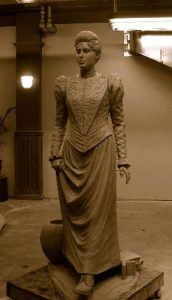
Statue honoring Helen J. Stewart in Las Vegas, NV.
Helen Stewart is most vividly remembered as an early advocate of formalized education in the valley. She taught her children herself for a while, but soon persuaded another Las Vegas pioneer, James Ross Megarrigle, a graduate of Oxford University, to hire on as a tutor. Later he would become the first accredited teacher listed in state records for the region. He would remain at that post until his death in 1894.
Helen was appointed postmaster “Los” Vegas Post Office in 1893. (The government had designated the spelling change to prevent confusion with the more popular metropolis of Las Vegas, New Mexico. It was not until 1903 that the original spelling was reinstituted.) The ranch also became the site for the new Los Vegas voting precinct.
Tragically, in a riding accident shortly after his fourteenth birthday, Archie Jr. was killed. This was the greatest blow of all to overcome for his mother. Though she would not allow her day-to-day duties to be neglected, the ranch would never seem the same to her again.
Plans for a railroad to lay track through the valley had long been rumored but it was not until 1902 that Helen Stewart signed a contract with Senator William Clark of Montana to sell the ranch to the San Pedro, Los Angeles, and Salt Lake Railroad. The price was $55,000. She retained the rights to 160 acres, including “Four Acres,” the rights to all the crops raised on the ranch that year, fifty head of cattle, fifteen horses, and four miner’s inches of water from the Las Vegas Creek for irrigation purposes. The Stewart children had all inherited one-tenth interest in the ranch at their father’s death. One by one, they deeded their shares back to their mother so the sale could proceed. The asking price for each of the shares was exactly the same for all the children: the sum of one dollar, with love and affection. Twenty years after their “temporary” move to the ranch, the deed of sale was executed.
In less than three years, Helen would acquire 924 acres adjacent to the land she sold the railroad. She knew that land values would soar with the railroad coming in, and she prepared.
That same year she also married Frank Stewart (no relation to Archibald) who had been hired as a ranch hand in 1886. It may have been the void left in her life at the passing of her close friend, Megarrigle, that made her begin to look at her foreman with new eyes, as she increasingly came to depend on him. She finally accepted his marriage proposal seventeen years after she had hired him, but only after he agreed to sign a prenuptial agreement basically giving up all rights to any property held by her at the time of their wedding. It would remain her sole and separate property. Frank never was accorded the same status of husbands of that era, and he understood that his wife had been the head of the family, and the ranch, for too long to accept less.
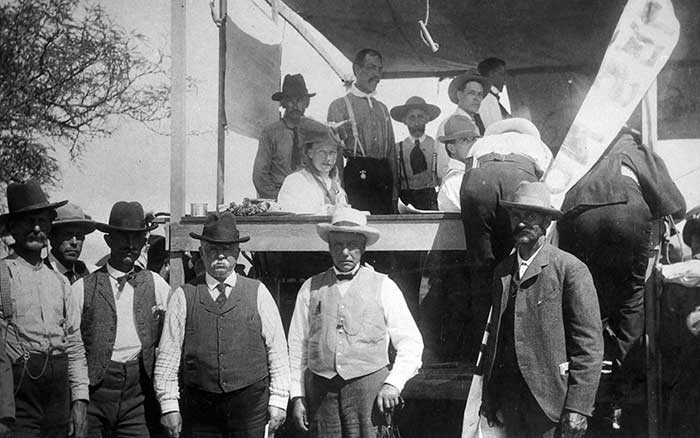
1905 Great Las Vegas Auction
The year 1905 saw 150 new buildings under construction or finished. By May 5, there had been 5000 applications on 1200 lots in Clark’s town site, and on that day the Great Auction was held. One of the main streets on the plot map was appropriately named “Stewart” for the acknowledged First Family of Las Vegas. Helen described the effect of such sudden growth “as if waking from a dream and (finding) all the comforts of an advanced civilization with us. The hardships were no more.”
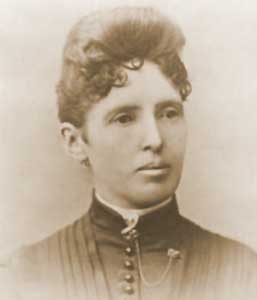
Helen J. Stewart as a businesswoman.
Nor was the loneliness, as Helen began to delve into the social whirl created by the arrival of numerous women to the area. She drank deeply of the new opportunities for the enjoyment and enrichment of cultural events unavailable to her for the previous twenty years. Her unpretentious habit of never saying an unkind remark to anyone endeared her to all, so she found herself included in all their activities.
The history of southern Nevada was an avid interest of Helen’s since her arrival. When Jeanne Elizabeth Weir, founder of the Nevada State Historical Society, visited Las Vegas in 1908 one of the first she came to see was Helen Stewart, for who was better qualified to lead the Society’s new Las Vegas chapter than she? Helen also joined the Society of Nevada Pioneers when it was organized in 1914. Perhaps the most important group she joined was the Mesquite Club, founded in 1911. In fact, Helen Stewart created the name, saying that if members could do as much for our community as the mesquite tree did for the valley’s first inhabitants, then they would be well-named.
She was also renowned as a collector of relics of local history. One item was the pen with which Nevada Governor Tasker Oddie signed the act of incorporation for the City of Las Vegas. She also had artifacts from the era of Spanish exploration found by miners near the Colorado River. Additionally, her collection of woven Paiute baskets had become so extensive that the Governor had expressed an interest in purchasing them by and for the State, to be housed at the Historical Society.
When Helen was the first woman to be elected to the new Clark County School Board, she ran as a Republican, was endorsed by the Democrats, and, as she said, “elected by all my friends.” She graciously accepted the post of Clerk for the Board but stipulated that the actual clerical work would be done by Mr. Street, principal of Clark High School. And so it was.
In February of 1916, for the first time in Clark County and possibly the whole state, ten women, including Helen Stewart, were subpoenaed to serve as jurors in Justice Court. Eight years later, she would also serve as a juror for a murder trial, the first time a woman in Nevada would serve on a jury for a capital crime. The attitude of most lawyers in an opinion poll at the time was that women were most unsuited for jury duty because of the sympathetic leanings of their gender.
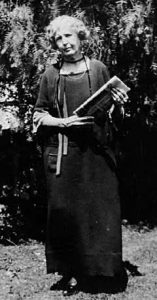
First Lady of Las Vegas – Helen J. Stewart
While the legal mavens harrumphed that one over, the four ladies on the jury proved to be harsher than the men in their judgments, finally being persuaded to change their votes to voluntary manslaughter from first-degree murder after three ballots.
Helen Jane Stewart was born on April 10, 1914, to Will and Mina Stewart and named for her grandmother. Helen found renewed joy in her granddaughter as she had not known since her youngest son’s death. But after several months it was found that her particularly difficult delivery had left the child mentally impaired. Helen merely redoubled the love and attention she gave naturally. She devoted herself to her granddaughter and delighted in her every small accomplishment. It was for this child that the Helen J. Stewart School for Mentally Impaired Children was named. The school stands today across the street from the “Four Acres” and Helen J. Stewart’s grave.
On March 6, 1926, Helen Stewart lost a long battle with cancer, having fought to the end. Her funeral procession was the largest witness in Las Vegas to that time. Among the crowds of people who passed by in the viewing line were the Paiutes, miners, cowboys, teamsters, prospectors, the high-born, and the down-home. The kind of men who were welcomed and befriended by this little woman, ever since the valley was a wilderness. Delphine Squires, wife of newspaper editor Pop Squires, and long-time friend of Helen’s would dub Helen J. Stewart “The First Lady of Las Vegas,” and say of her: “Her frail little body housed an indomitable will, a wonderful strength of purpose, and a courageous heart, and she faced death as she had faced life: with sublime fortitude.”
©Anthony Dee Varrone, for Legends of America, April 2021.

Author Anthony Dee Varrone
About the Author: Anthony Dee Varrone is a born and bred Las Vegas Native. A retired court officer for the Las Vegas Municipal Court, Varrone is an avid Old West buff with a special interest in the early days of his hometown.
Also See:
Sam Gay – The Sagebrush Sheriff